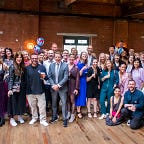Helping small businesses grow with design
With Innovate UK, we’ve helped hundreds of small businesses make use of design expertise to innovate, grow and recover post-pandemic.
The period of intense change gave us a very clear sense of the importance of the work that Magnetic do. There’s a pressing need to equip businesses of all sizes and stages with the design skills and knowledge to fuel their growth, and the confidence to try new things.
With Innovate UK EDGE we developed Design for Growth, a new national design coaching scheme for innovation-driven high growth potential businesses, in all sectors. Over eight months, it helped more than 160 high-growth SMEs. Design can be a powerful problem-solving tool and the scheme will help them integrate it and use it as a tool in their business. Learn more about the program here.
There are four common problems we see in small businesses, and how we used design as a solution that transformed the business:
- Finding customers by understanding their needs
- Standing out from the competition
- Finding funding and investment
- Developing new products and services
Let’s unpack each one:
- Finding customers by understanding their needs
Ada is a hugely popular healthcare app created by a team of medical professionals and scientists. They spent eight years developing its AI-powered diagnosis engine to help other medical professionals and scientists. They wanted to turn the tech into a system that helped the public.
What we did: To build a product that would work for customers, not specialists, we had to get under their skin, understanding their spoken and unspoken needs across global markets and very different healthcare cultures. We found that customers were surprisingly open with a virtual doctor, and they thought in-person GP visits were hurried and awkward. The average appointment lasts just nine minutes. So the Ada consultation was made longer.
The outcome: Once launched, Ada became one of Europe’s fastest-growing medical apps. In 2021 the team secured another £63m of funding.
2. Standing out from the competition
Since launching in 2013, Fourpure has been a story of breakneck expansion, investing millions in equipment and now employing more than 60 people. In 2018, they wanted to re-look at their branding and product range, how the market had changed, and what customers wanted.
What we did: We interviewed customers, and found that they’re a lot more diverse than the typical craft beer enthusiasts at the brewery’s beer nights. They told us the tagline, Inspired by adventure, wasn’t landing. They didn’t associate the brand with adventure, just with great beer.
In two days, we took the insights from our research and created new can designs, motifs and names (we call it Minimum Viable Branding). We invited 50 customers and potential customers to the taproom, and set up five experiment stations, where they played association games, compared brand desirability, and reacted to branding themes, colours and packaging concepts.
The outcome: A high-throughput design and branding lab that raised authentic questions in an authentic environment.
3. Finding funding and investment
Innerstrength Health is a health-tech startup in Dublin helping people with serious medical issues stay fit and feeling well. After the successful launch of their TickerFit app for heart patients, co-founders Avril and Greg wanted to secure investment to develop a new app to help teenagers (and their parents and doctors) manage cystic fibrosis. To win funding, they had to get closer to potential users.
What we did: The teenagers we spoke to in our customer research wanted to go to karate, play Minecraft, watch YouTube and go out with their friends. Cystic fibrosis gets in the way of living the life they want to live. They don’t identify as patients at all, nor as customers. They’re teenagers, and if we wanted them to use an app it would have to be interesting, useful and easy.
The outcome: Using the teens’ very honest feedback, Innerstrength was able to iterate the app and build something that serves their needs and they actually want to use. The learnings bolstered the business case too, and convinced investors to provide funding worth over €500k.
4. Developing new products and services
Dr Louise Newson, who runs a successful menopause clinic, worked with magneticNorth to develop Balance, a menopause support app.
What we did: During the research phase, we spoke to women who had been through the menopause to fully understand its impact. We shared raw and emotional moments with them, laughed with them, cried with them, drank tea and ate lots of biscuits.
To validate the ideas and insights we got from this, we built a community with 5,000 people who had signed up to receive updates and help us shape the app. Working in public was a risk, but it meant the app had been tested more than 1,000 times and optimised before launch.
The outcome: 80,000 sign-ups from 150 countries in nine months. The user-focused approach meant we designed a digital health solution that gave its audience exactly what they needed.
If you want to find out more about our work with Innovate UK, drop us a line.
This is an excerpt from our latest book Now for the tricky bit; it’s all about building stronger, happier businesses with purpose. Request a copy of our latest business book (coming soon) here.
